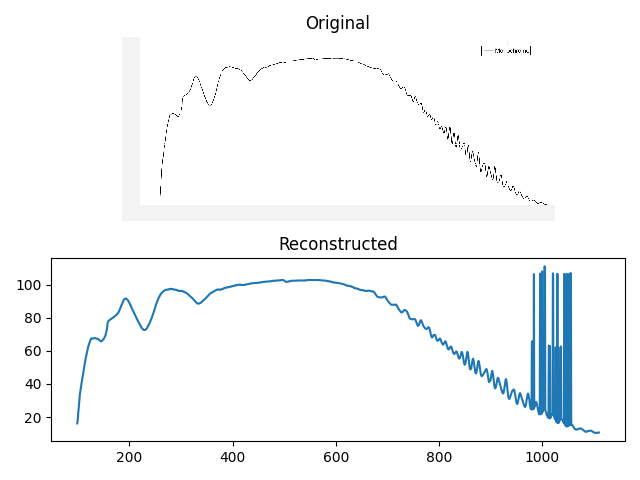A Python3 command line utility to digitize plots in batch mode.
This utility is useful when you have a lot of similar plots such as EEG, ECG recordings. See examples below.
For one-off use cases, you will find web-based digitizer WebPlotDigitizer by Ankit Rohatagi much more easier to use.
$ python3 -m pip install plotdigitizer
$ plotdigitizer --help
Crop the image and leave only axis and trajectories. I used the gthumb utility on Linux.
You can also use imagemagick or gimp.
The following image is from MacFadden and Koshland, PNAS 1990 after trimming. One should also remove top and right axes. I didn't because I want to highlight the limitation of this tool!
Run
plotdigitizer ./figures/trimmed.png -p 0,0 -p 10,0 -p 0,1We need at least three points (-p option) to map x- and y-axis onto the image.
In the example above, these are 0,0 (where x-axis and y-axis intersect) , 10,0 (a point on
the x-axis), and 0,1 (a point on the y-axis). To map these points on the image, you
will be asked to click on these points. Make sure to click in the same order and click on
the points as precisely as you could. Any error in this step will propagate.
If you don't have 0,0 in your image, you must provide 4 points: 2 on the x-axis and 2 on the y-axis.
The data points will be dumped to a CSV file specified by --output /path/to/file.csv.
If --plot output.png is passed, a plot of the extracted data points will be
saved to output.png. This requires matplotlib. Very useful when debugging/testing.
Notice the error near the right y-axis.
You can pass the coordinates of points in the image at the command prompt. This allows it to run in batch mode without any need for the user to click on the image.
plotdigitizer ./figures/trimmed.png -p 0,0 -p 20,0 -p 0,1 -l 22,295 -l 142,295 -l 22,215 --plot output.pngIn the example above, point 0,0 is mapped to coordinate 22,295 i.e., the
data point 0,0 is on the 22nd row and 295th column of the image (assuming that the bottom left
of the image is the first row, first column (0,0)). I have included a utility
plotdigitizer-locate (script plotdigitizer/locate.py), which you can use to
find the coordinates of points.
$ plotdigitizer-locate figures/trimmed.pngor, by directly using the script:
$ python3 plotdigitizer/locate.py figures/trimmed.pngThis command opens the image in a simple window. You can click on a point, and its coordinates will be written on the image. Note them down.
plotdigitizer figures/graphs_1.png \
-p 1,0 -p 6,0 -p 0,3 \
-l 165,160 -l 599,160 -l 85,60 \
--plot figures/graphs_1.result.png \
--preprocessplotdigitizer figures/ECGImage.png \
-p 1,0 -p 5,0 -p 0,1 \
-l 290,337 -l 1306,338 -l 106,83 \
--plot figures/ECGImage.result.png
plotdigitizer figures/graph_with_grid.png \
-p 200,0 -p 1000,0 -p 0,50 \
-l 269,69 -l 1789,69 -l 82,542 \
--plot figures/graph_with_grid.result.png
Note that legend was not removed in the original figure and it has screwed up the detection below it.
This application has the following limitations:
- Only b/w images are supported for now. Color images will be converted to grayscale upon reading.
- Each plot should have only one trajectory.
Open an issue and please attach the sample plot.
- WebPlotDigitizer by Ankit Rohatagi is very versatile.








